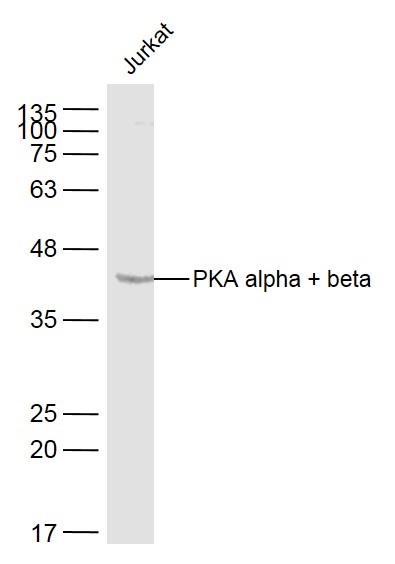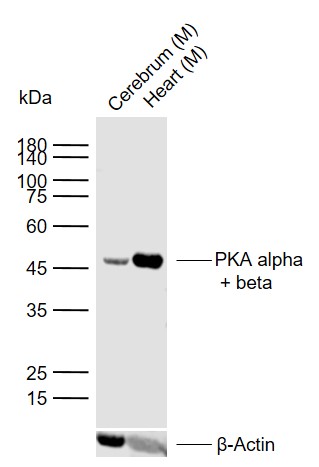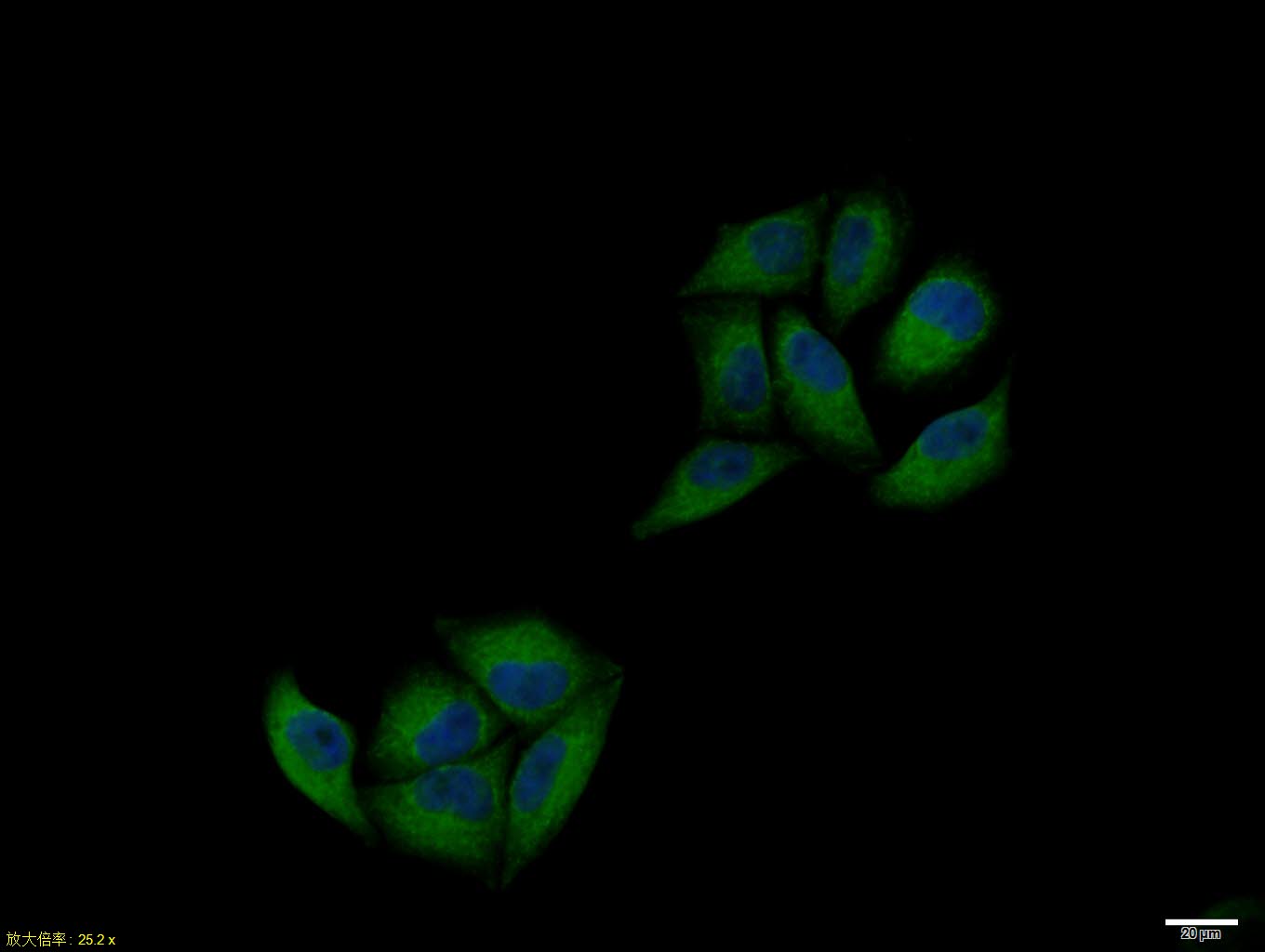
Rabbit Anti-PKA alpha + beta antibody
PRKACA/PRKACB; PRKACA + PRKACB; PKA alpha + beta; PKA alpha; PKA beta; cAMP dependent protein kinase alpha catalytic subunit; cAMP dependent protein kinase beta catalytic subunit; cAMP dependent protein kinase catalytic subunit alpha; cAMP dependent prote
View History [Clear]
Details
Product Name PKA alpha + beta Chinese Name 蛋白激酶A抗体 Alias PRKACA/PRKACB; PRKACA + PRKACB; PKA alpha + beta; PKA alpha; PKA beta; cAMP dependent protein kinase alpha catalytic subunit; cAMP dependent protein kinase beta catalytic subunit; cAMP dependent protein kinase catalytic subunit alpha; cAMP dependent protein kinase catalytic subunit beta; DKFZp781I2452; MGC102831; MGC41879; MGC48865; MGC9320; PKA C alpha; PKA C beta; PKACA; PKACB; PRKACA; PRKACB; Protein kinase A catalytic subunit alpha; Protein kinase A catalytic subunit; Protein kinase A catalytic subunit beta; Protein kinase cAMP dependent catalytic alpha; Protein kinase cAMP dependent catalytic beta; cAMP dependent protein kinase catalytic subunit alpha isoform 1; cAMP-dependent protein kinase catalytic subunit alpha; KAPCA_HUMAN; KAPCB_HUMAN; PKA C alpha; PKA C-alpha; PKACA; PRKACA; Protein kinase A catalytic subunit; Protein kinase cAMP dependent catalytic alpha. literatures Research Area Cell biology Signal transduction Apoptosis Kinases and Phosphatases Immunogen Species Rabbit Clonality Polyclonal React Species Human, Mouse, (predicted: Rat, ) Applications WB=1:500-2000 ELISA=1:5000-10000 IHC-P=1:100-500 IHC-F=1:100-500 ICC=1:100 IF=1:100-500 (Paraffin sections need antigen repair)
not yet tested in other applications.
optimal dilutions/concentrations should be determined by the end user.Theoretical molecular weight 40kDa Cellular localization The nucleus cytoplasmic The cell membrane Form Liquid Concentration 1mg/ml immunogen KLH conjugated synthetic peptide derived from human PRKACA/PRKACB : 17-100/351 Lsotype IgG Purification affinity purified by Protein A Buffer Solution 0.01M TBS(pH7.4) with 1% BSA, 0.03% Proclin300 and 50% Glycerol. Storage Shipped at 4℃. Store at -20 °C for one year. Avoid repeated freeze/thaw cycles. Attention This product as supplied is intended for research use only, not for use in human, therapeutic or diagnostic applications. PubMed PubMed Product Detail cAMP is a signaling molecule important for a variety of cellular functions. cAMP exerts its effects by activating the cAMP-dependent protein kinase, which transduces the signal through phosphorylation of different target proteins. The inactive kinase holoenzyme is a tetramer composed of two regulatory and two catalytic subunits. cAMP causes the dissociation of the inactive holoenzyme into a dimer of regulatory subunits bound to four cAMP and two free monomeric catalytic subunits. Four different regulatory subunits and three catalytic subunits have been identified in humans. The protein encoded by this gene is a member of the Ser/Thr protein kinase family and is a catalytic subunit of cAMP-dependent protein kinase. Alternatively spliced transcript variants encoding distinct isoforms have been observed. [provided by RefSeq, Jul 2008]
Function:
Phosphorylates a large number of substrates in the cytoplasm and the nucleus. Regulates the abundance of compartmentalized pools of its regulatory subunits through phosphorylation of PJA2 which binds and ubiquitinates these subunits, leading to their subsequent proteolysis. Phosphorylates CDC25B, ABL1, NFKB1, CLDN3, PSMC5/RPT6, PJA2, RYR2, RORA, TRPC1 and VASP. RORA is activated by phosphorylation. Required for glucose-mediated adipogenic differentiation increase and osteogenic differentiation inhibition from osteoblasts. Involved in the regulation of platelets in response to thrombin and collagen; maintains circulating platelets in a resting state by phosphorylating proteins in numerous platelet inhibitory pathways when in complex with NF-kappa-B (NFKB1 and NFKB2) and I-kappa-B-alpha (NFKBIA), but thrombin and collagen disrupt these complexes and free active PRKACA stimulates platelets and leads to platelet aggregation by phosphorylating VASP. Prevents the antiproliferative and anti-invasive effects of alpha-difluoromethylornithine in breast cancer cells when activated. RYR2 channel activity is potentiated by phosphorylation in presence of luminal Ca(2+), leading to reduced amplitude and increased frequency of store overload-induced Ca(2+) release (SOICR) characterized by an increased rate of Ca(2+) release and propagation velocity of spontaneous Ca(2+) waves, despite reduced wave amplitude and resting cytosolic Ca(2+). TRPC1 activation by phosphorylation promotes Ca(2+) influx, essential for the increase in permeability induced by thrombin in confluent endothelial monolayers. PSMC5/RPT6 activation by phosphorylation stimulates proteasome. Regulates negatively tight junction (TJs) in ovarian cancer cells via CLDN3 phosphorylation. NFKB1 phosphorylation promotes NF-kappa-B p50-p50 DNA binding. Involved in embryonic development by down-regulating the Hedgehog (Hh) signaling pathway that determines embryo pattern formation and morphogenesis. Isoform 2 phosphorylates and activates ABL1 in sperm flagellum to promote spermatozoa capacitation. Prevents meiosis resumption in prophase-arrested oocytes via CDC25B inactivation by phosphorylation. May also regulate rapid eye movement (REM) sleep in the pedunculopontine tegmental (PPT). Phosphorylates APOBEC3G and AICDA.
Subunit:
A number of inactive tetrameric holoenzymes are produced by the combination of homo- or heterodimers of the different regulatory subunits associated with two catalytic subunits. cAMP causes the dissociation of the inactive holoenzyme into a dimer of regulatory subunits bound to four cAMP and two free monomeric catalytic subunits. The cAMP-dependent protein kinase catalytic subunit binds PJA2. Both isoforms 1 and 2 forms activate cAMP-sensitive PKAI and PKAII holoenzymes by interacting with regulatory subunit (R) of PKA, PRKAR1A/PKR1 and PRKAR2A/PKR2, respectively. Interacts with NFKB1, NFKB2 and NFKBIA in platelets; these interactions are disrupted by thrombin and collagen. Binds to ABL1 in spermatozoa and with CDC25B in oocytes. Interacts with APOBEC3G and AICDA.
Subcellular Location:
Cytoplasm. Cell membrane. Nucleus. Mitochondrion. Note=Translocates into the nucleus (monomeric catalytic subunit). The inactive holoenzyme is found in the cytoplasm. Distributed throughout the cytoplasm in meiotically incompetent oocytes. Associated to mitochondrion as meiotic competence is acquired. Aggregates around the germinal vesicles (GV) at the immature GV stage oocytes.
Tissue Specificity:
Isoform 1 is ubiquitous. Isoform 2 is sperm specific.
Post-translational modifications:
Asn-3 is partially deaminated to Asp giving rise to 2 major isoelectric variants, called CB and CA respectively.
Autophosphorylated. Phosphorylation is enhanced by vitamin K(2). Phosphorylated on threonine and serine residues. Phosphorylation on Thr-198 is required for full activity.
Phosphorylated at Tyr-331 by activated receptor tyrosine kinases EGFR and PDGFR; this increases catalytic efficienncy.
Similarity:
Belongs to the protein kinase superfamily. AGC Ser/Thr protein kinase family. cAMP subfamily.
Contains 1 AGC-kinase C-terminal domain.
Contains 1 protein kinase domain.
SWISS:
P17612
Gene ID:
5566
Database links:Entrez Gene: 5566 Human
Entrez Gene: 5567 Human
Entrez Gene: 18747 Mouse
Entrez Gene: 18749 Mouse
Omim: 176892 Human
Omim: 601639 Human
SwissProt: P17612 Human
SwissProt: P22694 Human
SwissProt: P05132 Mouse
SwissProt: P05206 Mouse
Unigene: 487325 Human
Unigene: 631630 Human
Unigene: 16766 Mouse
Unigene: 19111 Mouse
Unigene: 103828 Rat
Kinases and Phosphatases(Kinases and Phosphatases)
蛋白激酶 A (protein kinase A,PKA) 又称依赖于cAMP的蛋白激酶A (cyclic-AMP dependent protein kinase A),是一种结构最简单、生化特性最清楚的蛋白激酶。
蛋白激酶A属于多功能丝氨酸和苏氨酸激酶,可使蛋白磷酸化,也可自身磷酸化。在调节细胞存活中起重要作用。Product Picture
Jurkat(Human) Cell Lysate at 40 ug
Primary: Anti-PKA alpha + beta (SL0520R) at 1/300 dilution
Secondary: IRDye800CW Goat Anti-Rabbit IgG at 1/20000 dilution
Predicted band size: 40 kD
Observed band size: 40 kD
Sample:
Lane 1: Mouse Cerebellum tissue lysates
Lane 2: Mouse Heart tissue lysates
Primary: Anti-PKA alpha + beta (SL0520R) at 1/1000 dilution
Secondary: IRDye800CW Goat Anti- Rabbit IgG at 1/20000 dilution
Predicted band size: 40 kDa
Observed band size: 45 kDa
Hela cell; 4% Paraformaldehyde-fixed; Triton X-100 at room temperature for 20 min; Blocking buffer (normal goat serum, C-0005) at 37°C for 20 min; Antibody incubation with (PKA alpha + beta) polyclonal Antibody, Unconjugated (SL0520R) 1:100, 90 minutes at 37°C; followed by a conjugated Goat Anti-Rabbit IgG antibody at 37°C for 90 minutes, DAPI (blue, C02-04002) was used to stain the cell nuclei.
Bought notes(bought amounts latest0)
No one bought this product
User Comment(Total0User Comment Num)
- No comment





 +86 571 56623320
+86 571 56623320
 +86 18668110335
+86 18668110335

